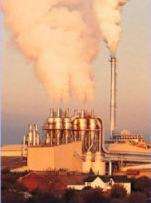Point source pollution
For other uses, see Point source (disambiguation).

Industrial point sources of air pollution.
A point source of pollution is a single identifiable source of air, water, thermal, noise or light pollution. A point source has negligible extent, distinguishing it from other pollution source geometries. The sources are called point sources because in mathematical modeling, they can be approximated as a mathematical point to simplify analysis. Pollution point sources are identical to other physics, engineering, optics, and chemistry point sources and include:
- Air pollution from an industrial source, rather than an airport or a road, considered a line source or a forest fire which is considered an area source, or volume source.
- Water pollution from an oil refinery wastewater discharge outlet[1]
- Noise pollution from a jet engine
- Disruptive seismic vibration from a localized seismic study
- Light pollution from an intrusive street light
- Thermal pollution from an industrial process outfall
- Radio emissions from an interference-producing electrical device
References
- ↑ C.Michael Hogan. 2010. Water pollution. Encyclopedia of Earth, Topic ed. Mark McGinley, ed. in chief C.Cleveland, National Council on Science and the Environment, Washington DC
This article is issued from Wikipedia - version of the 11/3/2016. The text is available under the Creative Commons Attribution/Share Alike but additional terms may apply for the media files.